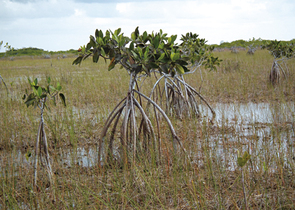The Journal is published by the Nature Conservation Agency of the Czech Republic in cooperation with the Cave Administration of the Czech Republic, the Krkonoše Mts. National Park Administration, the Bohemian Forest Mts. National Park Administration, the Podyjí National Park Administration and the The Bohemian Switzerland National Park Administration. It has been published since 1946.
cs / en
Nature Conservation 4/2012 — 9. 11. 2012 — International Nature Conservation — Print article in pdf
Plesník J. & Pelc F.: The Everglades National Park – Water Availability Has Been Crucial for its Fat

The Everglades National Park situated in southern Florida and covering 6,105 km2is the largest subtropical wilderness in the United States: it was declared in 1947. The protected area is a flat network of wetlands and forests fed by a river flowing only 400 m per day out of the Lake Okeechoobee, southwest into Florida Bay.
The Park is the most significant breeding ground for the tropical wading birds in North America and it harbours the largest continuous mangrove growth worldwide. Freshwater channels are characterized by low-lying areas covered in fresh water: sawgrass prairies lacking even the slow movement of surface water are so prominent in the region that the Native Americans called it “River of Grass”. The only dry land within the park is hammocks which rise several inches above the grass-covered river and consist of tropical and subtropical hardwood forest.
In the late 19thcentury the wetlands began to be drained to obtain new land for agricultural and residential use there. As the 20thcentury progressed, water flow from the Lake Okeechobee was increasingly controlled and diverted to enable explosive growth of the South Florida metropolitan area.
In 2000, the Congress approved the Comprehensive Everglades Restoration Plan (CERP), a USD 10.5 billion project that is expected to take 30+ years to complete. The CERP approach is to use the best available science to restore the South Florida’s natural ecosystems while maintaining urban and water supply and flood control.

